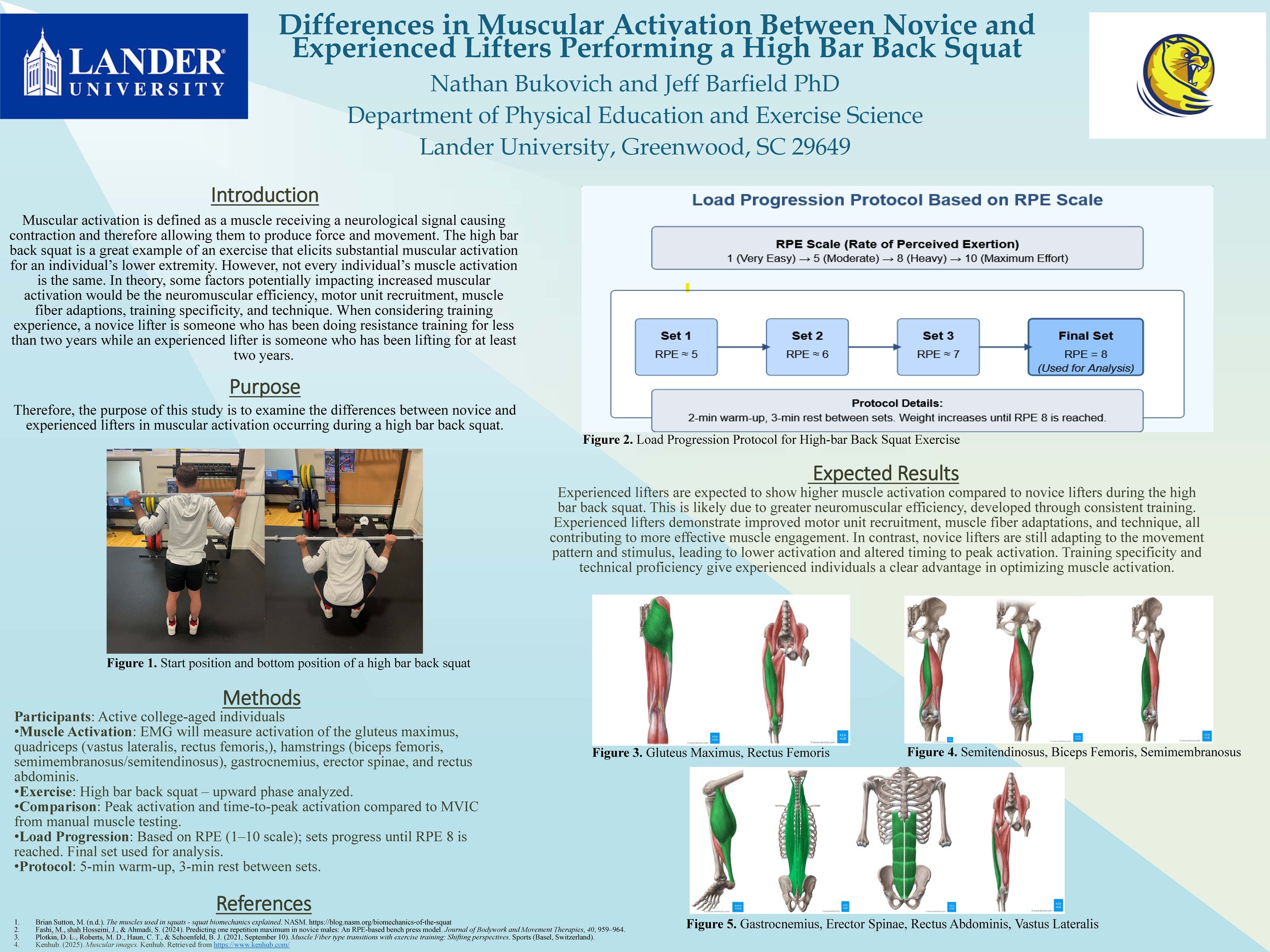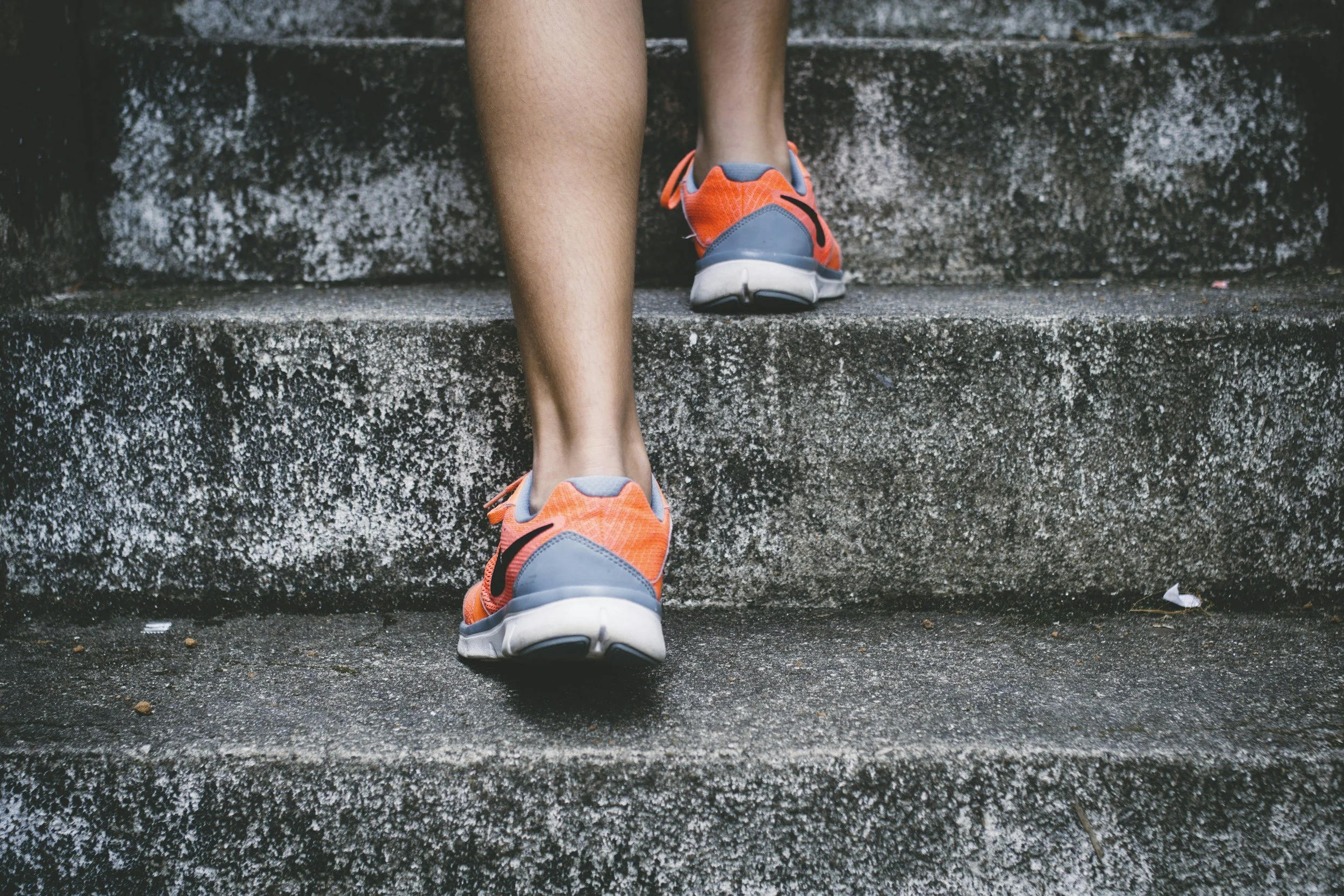Multidisciplinary Poster Session -
Exercise Science
held on April 24, 2025 at the Lander University Academic Symposium
Faculty Sponsors: Jeff Barfield - Bruna Lynch
Presenters: Nathan Bukovich - Ryann Swope & Riley Wolters - Aleaya Turman - Madison Usry & Kathryn Patterson
Scroll to view all projects!
-
![]()
Nathan Bukovich
Click here to examine the poster.
The difference in muscular activation between a novice lifter and experience lifter when performing a high bar back squat
Novice and experienced lifters differ with their neuromuscular efficiency seen through motor unit recruitment, exercise technique, and strength level. In theory, the experience lifters should have more intra- and intermuscular coordination compared to a novice lifter. A multi-joint compound movement such as the high back squat is an excellent way to test muscular coordination due to the number of muscles used in this movement. Therefore, the purpose of this research would be to see if there is a difference in muscular activation and coordination between a novice lifter and an experience lifter when performing a high bar back squat. For this research, participants will be college-aged individuals split into two groups (Experienced and Novice Lifters). Experience lifters will be lifters that have been consistently involved in resistance training for at least two years whereas novice lifters will be lifters that have been lifting for less than two years. Electromyography will be used to measure the muscular activation for the following muscles: Gluteus Maximus, Vastus lateralis, rectus femoris, Medial hamstring (Semimembranosus and Semitendinosus), Biceps Femoris, Vastus medialis oblique, gastrocnemius, erector spinae, and the rectus abdominis. Peak muscle activation and timing to peak muscle activation for the upward phase of the high bar back squat will be analyzed and compared to maximal volitional isometric contractions (MVIC) of the same musculature obtained through manual muscle testing. The intensity for both groups will be based off ratings of perceived exertion (RPE 1-10). The procedure will start with a 5 min stretching warm up followed by sets. These will start with the bar and increase gradually based off each participant’s RPE. Once a RPE of 8 has been reached for a set, then sets will end and data from the last set will be analyzed. There will be a three-minute rest period between sets. The expected results would be that the experience lifter would have improved intra- and intermuscular coordination compared to the novice lifter. This is because an experienced lifter will have higher neuromuscular efficiency obtained through training specificity and observed through increased motor unit recruitment, muscle fiber adaptations, training specificity, and technique.
Nathan Bukovich graduated from Chattahoochee High School in Johns Creek, Georgia. He is a senior exercise science major with a minor in business sports management. He is currently on Lander’s wrestling team and plans to pursue his masters in Exercise science with an emphasis in Sport Performance & Rehabilitation at Lander University. -
![]()
Ryann Swope & Riley Wolters
Move More, Feel Better: How Sedentary Behavior and Physical Activity Shape University Students’ Health-Related Quality of Life
Reduced sedentary behavior (SB) and increased physical activity (PA) are strongly linked to improved health-related quality of life (HRQOL), a key indicator of physical, psychological, and social well-being. Awareness of one's SB and PA levels can play a crucial role in promoting healthier lifestyles, particularly among university students. Objective: To examine the effects of SB and moderate to vigorous-intensity physical activity (MVPA) on the eight domains of HRQOL in university students. Methods: Undergraduate students at Lander University (Greenwood, SC) were invited to participate (n = 120; 83 females and 37 males). HRQOL was assessed using the Short Form 36 Health Survey Questionnaire (SF-36), which evaluates eight domains: physical functioning, role limitations due to physical problems, role limitations due to emotional problems, energy/fatigue, emotional well-being, social functioning, bodily pain, and general health perception (higher scores indicate better HRQOL). SB and PA levels (duration and intensity) were measured over a 7-day period using the ActiGraph GT3X+ triaxial accelerometer (ActiGraph, LLC, Pensacola, FL, USA). Participants were categorized into two groups for SB: less or more than 10 hours of SB per day; and two groups for MVPA: less or more than 150 minutes of MVPA per week. Group comparisons were conducted using independent sample t-tests, with significance set at p < 0.05. Statistical analyses were performed using SPSS (IBM SPSS Statistics, version 29). Results: Participants with less than 10 hours per day of SB had significantly higher scores in energy/fatigue (62.14 ± 13.56 vs. 53.93 ± 16.39; p-value = 0.034) than participants with more than 10 hours of SB per day. Participants with more than 150 minutes per week of MVPA had significantly higher scores in emotional well-being (75.58 ± 12.90 vs. 68.57 ± 16.53; p-value = 0.029), social functioning (87.35 ± 15.85 vs. 80.36 ± 19.95; p-value = 0.044), and general health (74.65 ± 14.20 vs. 68.00 ± 14.31; p-value = 0.022) than participants without 150 minutes per week of MVPA. Conclusion: University students who engaged in less than 10 hours of SB per day reported higher energy levels, while those meeting MVPA guidelines experienced greater emotional well-being, social functioning, and general health perception. These findings emphasize the importance of reducing sedentary time and increasing PA to enhance overall health-related quality of life in young adults.
Ryann is a senior Exercise Science major at Lander University and graduated from Twin Falls High School in Twin Falls, ID. Ryann is on the Acrobatics and Tumbling team at Lander. She has been on the Dean’s list for 3 years and has maintained a 3.35 GPA. Ryann will graduate in Spring of 2025, then will continue her education at Lander University to earn her masters in Exercise Science as well as coach for the Acrobatics and Tumbling team. After Lander University, Ryann plans on applying to DPT school.
Riley Wolters graduated from North Myrtle Beach High School in North Myrtle Beach, SC. Riley is a senior Exercise Science major and will be attending Palmer College of Chiropractic in the Fall of 2025. Riley is on the Acrobatics and Tumbling team along with the Track and Field team at Lander University. Riley is a member of the Chi Alpha Sigma for athletic and academic achievements. Riley has been an active student on the Dean’s list with a 3.50 GPA.
-
![]()
Aleaya Turman
Click here to examine the poster.
How Muscular Strength and Central Adiposity Influence University Students' Health-Related Quality of Life
Elevated waist circumference (WC) negatively impacts health-related quality of life (HRQOL), while muscular strength has a positive effect. Studying these variables in university students is important, as this period shapes long-term health behaviors. Objective: To examine how central adiposity and muscular strength influence the eight domains of HRQOL among university students. Methods: Undergraduate students at Lander University (Greenwood, SC) were invited to participate (n = 120; 83 females and 37 males). HRQOL was assessed using the Short Form 36 Health Survey Questionnaire (SF-36), which evaluates eight domains: physical functioning, role limitations due to physical problems, role limitations due to emotional problems, energy/fatigue, emotional well-being, social functioning, bodily pain, and general health perception (higher scores indicate better HRQOL). Central adiposity was assessed through WC, measured at the narrowest point, and participants were categorized into two groups: altered (females >88cm, males >120cm) or normal WC. Muscular strength was assessed using a Jamar hydraulic hand dynamometer, and participants were categorized into two groups (<P75 or >P75) according to percentiles based on grip strength fitness categories by sex. Group comparisons were conducted using independent sample t-tests, with significance set at p < 0.05. Statistical analyses were performed using SPSS (IBM SPSS Statistics, version 29). Results: Individuals with normal WC had significantly higher scores regarding general health perception than those with altered WC (74.31 ± 14.14 vs. 64.21 ± 13.67; p-value = 0.005). Additionally, individuals with grip strength >P75 had significantly higher scores on role limitations due to physical problems than those with grip strength <P75 (97.45 ± 10.51 vs. 88.38 ± 24.58; p-value = 0.007). Conclusion: University students with lower central adiposity reported better general health perception, while those with greater muscular strength experienced fewer physical limitations. These findings reinforce the importance of maintaining a healthy WC and building muscular strength to enhance overall HRQOL during this formative stage of life.
Aleaya Turman graduated from Greenwood High School in Greenwood, South Carolina. She is currently a senior in Fitness & Wellness at Lander University. Her achievements include interning at the Jeff May Complex at Lander and the YMCA. She would like to pursue a career in exercise physiology after graduation.
-
![]()
Madison Usry & Kathryn Patterson
Moving or Sitting? A Descriptive Study of Physical Activity and Sedentary Behavior Among PEES Undergraduate Students
Physical activity (PA) and sedentary behavior (SB) play a crucial role in overall health, particularly among college students preparing for careers in Physical Education and Exercise Science (PEES). Understanding their engagement in different PA intensities and SB patterns can provide insight into their lifestyle habits and potential areas for improvement. Objective: This study examines PA and SB levels among non-athlete PEES majors to assess their adherence to recommended activity guidelines. Methods: Non-athlete undergraduate students enrolled in PEES majors at Lander University (Greenwood, SC) were invited to participate (n = 62) in the study. PA levels, including duration and intensity, as well as SB, were measured over a 7-day period using the ActiGraph GT3X+ triaxial accelerometer (ActiGraph, LLC, Pensacola, FL, USA). Student-athletes were excluded from the study. Descriptive analyses were conducted using SPSS (IBM SPSS Statistics, version 29). Results: 42 females (67.7%) and 20 males (32.3%) completed the study, and the mean age was 20.78 ± 2.70 years. 19.4% of participants accumulated less than 10 hours in SB (12.98 ± 3.64) per day, 50% of participants accumulated more than 4 hours of light PA per day (4.04 ± 1.34), and 58.1% of the participants met the American College of Sports Medicine (ACSM) recommendation of 150 minutes of moderate to vigorous PA per day (193.01 ± 102.06). Conclusion: While most PEES students met the recommended ACSM recommendation of moderate to vigorous PA, a significant portion still engaged in high SB. These findings highlight the need for strategies to reduce sedentary time and promote more active lifestyles, even among future professionals in the field of physical education and exercise science.
Madison Usry graduated from North Augusta High School in North Augusta, SC. She is currently a senior Exercise Science major at Lander University with a focus on physical therapy. Throughout her time at Lander University, she has been a part of the PEES Club, PEES Leadership Team, and Dean’s/President’s list. She has also completed two internships at Self Regional Hospital with the outpatient physical therapy department and the orthopedic physical therapy department, along with another internship with CORA physical therapy. She has future career goals of becoming a physical therapist upon graduation.
Reese Patterson graduated from Belton-Honea Path High School in Belton, SC. She is currently a senior Exercise Science major focusing on physical therapy and minoring in therapeutic horsemanship. She is currently a part of the PEES Leadership team, and she has made it on the President’s List each semester at Lander. Reese will be graduating this May and starting Anderson University’s DPT program following graduation.



